
Journal of Ancient Near Eastern History
Scope & Guideline
Fostering Dialogue on Ancient Cultures and Their Impact
Introduction
Aims and Scopes
- Interdisciplinary Research:
The journal encourages research that integrates various disciplines such as archaeology, history, anthropology, and linguistics to provide comprehensive insights into ancient Near Eastern societies. - Focus on Marginality and Liminality:
A significant theme is the exploration of marginal and liminal groups, examining their roles, statuses, and contributions within broader societal structures in ancient civilizations. - Economic and Social Dynamics:
Research often investigates economic systems, trade networks, and social hierarchies, shedding light on the complexities of status, agency, and power in ancient societies. - Political History and Agency:
The journal emphasizes studies on political dynamics, local agency in imperial contexts, and the socio-political transformations that occurred throughout the ancient Near East. - Cultural and Religious Practices:
Explorations of cultural practices, religious beliefs, and scientific knowledge in ancient societies are key areas of focus, particularly in how these elements influenced societal development.
Trending and Emerging
- Resilience and Collapse Studies:
Recent publications increasingly focus on resilience and collapse within ancient societies, exploring how communities responded to crises and transformed over time, reflecting a broader interest in sustainability and adaptation. - Agency and Local Dynamics:
There is a growing emphasis on local agency in historical narratives, particularly how individuals and marginalized groups navigated and influenced their environments, challenging traditional top-down historical interpretations. - Economic Interactions and Trade Networks:
Research on economic systems, trade relations, and their impacts on societal structures is gaining traction, highlighting the interconnectedness of ancient Near Eastern societies. - Cultural Identity and Transformation:
Emerging studies are exploring the complexities of cultural identity and transformation, particularly in the context of imperial dynamics and cross-cultural interactions, providing new insights into the formation of identities. - Scientific and Technological Knowledge:
There is an increasing interest in the scientific practices and technological advancements of ancient societies, particularly in astronomy, mathematics, and medicine, reflecting a broader trend towards understanding the intellectual achievements of the ancient Near East.
Declining or Waning
- Traditional Chronological Studies:
Research centered on strict chronological frameworks and timelines appears to be decreasing, with a shift towards thematic and interdisciplinary approaches that prioritize social and cultural contexts over mere chronology. - Mythical Interpretations of History:
There seems to be a decline in studies that interpret historical events through purely mythical lenses, as scholars increasingly focus on empirical evidence and critical analysis of historical narratives. - Overemphasis on Grand Narratives:
There is a noticeable reduction in works that attempt to construct grand narratives of ancient civilizations, as the journal's focus shifts towards more localized, nuanced studies that highlight diversity and complexity.
Similar Journals

Adalya
Fostering Insightful Dialogues on History and ConservationAdalya, published by the esteemed Koc University Suna & Inan Kirac Research Center for Mediterranean Civilizations (AKMED), is a prominent academic journal dedicated to the fields of Archeology, History, and Conservation. With an ISSN of 1301-2746, this journal serves as an essential platform for scholars and researchers, fostering insightful discussions and disseminating significant findings about Mediterranean civilizations. Recognized in the quartile rankings of Q3 in Archeology and Q2 in both Conservation and History for the year 2023, Adalya reflects an impactful presence in its respective disciplines. Although it operates under a traditional subscription model, the journal remains accessible to a diverse audience interested in the nuanced exploration of historical contexts and conservation practices. Located in Antalya, Turkey, the journal has carved out a niche since its inception in 2009, bridging the past and present through rigorous academic inquiry. Whether you are a seasoned researcher or a student eager to deepen your understanding of Mediterranean cultures, Adalya offers invaluable resources and perspectives that enrich the academic community.
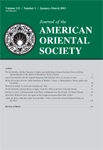
JOURNAL OF THE AMERICAN ORIENTAL SOCIETY
Exploring the Depths of Asiatic HeritageThe JOURNAL OF THE AMERICAN ORIENTAL SOCIETY, published by the American Oriental Society, is a prestigious academic journal based in the United States that serves as a vital resource for researchers and scholars engaged in the fields of Asiatic studies, cultural studies, and broader humanities. Established to foster scholarly communication, this journal presents rigorous peer-reviewed articles and critical analyses that explore the diverse cultural, historical, and linguistic dimensions of the Orient. With an impact factor reflecting its scholarly significance, it occupies a Q3 position in Arts and Humanities (miscellaneous) and a Q2 ranking in Cultural Studies as of 2023. Although it does not currently offer open access, the journal maintains a strong reputation for its scholarly contributions, making it an essential platform for disseminating research findings. By bridging gaps in knowledge and fostering interdisciplinary dialogue, the JOURNAL OF THE AMERICAN ORIENTAL SOCIETY remains a cornerstone for those committed to the exploration of Asian cultural heritage and philosophy, enriching the academic community's understanding in these vital fields.

Bulletin of the American Society of Overseas Research
Uncovering the past, shaping the future of cultural studies.Bulletin of the American Society of Overseas Research, published by the University of Chicago Press, serves as a premier platform for scholarly discourse in the fields of archaeology, cultural studies, and history. With its ISSN 2769-3600 and E-ISSN 2769-3589, this journal has swiftly established itself as a key resource for researchers, professionals, and students alike, demonstrating exceptional impact as evidenced by its Q1 rankings in multiple relevant categories for 2023. Notably, it holds the 93rd percentile rank in Arts and Humanities (History) and the 84th percentile in Social Sciences (Cultural Studies), evidencing its respected standing within the academic community. The journal's commitment to advancing knowledge and fostering interdisciplinary dialogue is complemented by its accessible publication from 2022 to 2024, making it an essential read for those engaged in the exploration of global cultural histories and archaeological research.
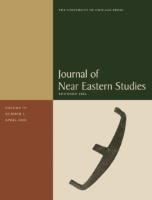
JOURNAL OF NEAR EASTERN STUDIES
Charting the Course of Cultural and Linguistic EvolutionJournal of Near Eastern Studies (ISSN: 0022-2968; E-ISSN: 1545-6978), published by University of Chicago Press, stands as a cornerstone of academic discourse in the fields of Archaeology, Cultural Studies, and Linguistics and Language. With a prestigious track record that has evolved since its inception and spanning converged publication years from 1968 to 2024, this journal holds an impressive Q1 ranking in Cultural Studies and Linguistics and Language, and a solid Q2 ranking in Archaeology and Arts and Humanities as of 2023. Despite not offering open access, it is widely regarded for its rigorous peer-reviewed articles that contribute significantly to the understanding of Near Eastern history, culture, and languages. The journal's sustained recognition in Scopus rankings, including a notable 30th rank out of 173 in Arts and Humanities, ensures it remains an essential resource for researchers, academics, and students dedicated to exploring the rich tapestry of the Near East. With its base in Chicago, USA, the Journal of Near Eastern Studies continues to foster interdisciplinary collaboration and scholarly excellence.
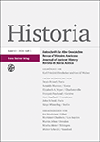
HISTORIA-ZEITSCHRIFT FUR ALTE GESCHICHTE
Fostering Exploration: Connecting Scholars to the Wonders of the PastHISTORIA-ZEITSCHRIFT FUR ALTE GESCHICHTE, published by FRANZ STEINER VERLAG GMBH, is a premier open-access journal dedicated to the rigorous exploration of ancient history, bridging critical insights from classics and historical studies since its inception in 1976. This distinguished publication, recognized with a Q1 ranking in both Classics and History for 2023, serves as a vital platform for researchers, professionals, and students alike, fostering interdisciplinary dialogue and advancing scholarship in the field. With a notable standing in Scopus, ranking #12 out of 170 in Classics and #288 out of 1760 in History, it addresses pivotal topics and emerging trends relevant to contemporary historiography. The journal’s commitment to open access, established in 2010, ensures that knowledge is widely disseminated, cultivating an inclusive academic community. For those dedicated to uncovering the nuances of ancient civilizations, HISTORIA remains an indispensable resource that significantly contributes to the global discourse on our historical heritage.

Rivista Storica Dell Antichita
Exploring the Depths of AntiquityRivista Storica Dell Antichita is a distinguished academic journal published by PATRON EDITORE S R L, dedicated to advancing knowledge in the fields of Archaeology, Classics, and History. With an ISSN of 0300-340X, this journal serves as a crucial platform for scholars and researchers who seek to delve into the rich historical narratives of antiquity. Although it has discontinued its coverage in Scopus after 2021, its legacy reflects a commitment to fostering scholarly dialogue within the academic community, evident from its rankings in notable Scopus categories, including Q3 in Classics and Q4 in Archaeology and History. Additionally, Rivista Storica Dell Antichita boasts a substantial readership in Italy, contributing to the understanding of historical contexts and methodologies. As scholars engage with its authentic research articles, they will find in this journal a valuable resource that not only enhances academic discourse but also inspires future explorations into the ancient world.
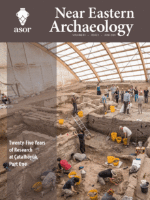
NEAR EASTERN ARCHAEOLOGY
Pioneering Insights into Archaeology and HistoryNEAR EASTERN ARCHAEOLOGY, published by University of Chicago Press, is a premier journal dedicated to the field of archaeology, particularly focusing on the rich cultural heritage and archaeological findings of the Near East. With an ISSN of 1094-2076 and an E-ISSN of 2325-5404, this esteemed publication provides a vital platform for scholars and practitioners to share their research, insights, and discoveries. The journal holds an impressive ranking in the Q1 quartile for both Archaeology and History in 2023, reflecting its significant impact within these fields and a robust history of scholarly contribution. The journal has been pivotal in shaping discussions around archaeological methodology, theory, and contemporary issues from 2002 to 2024, as it continues to reach a wide audience through various access options. With Scopus rankings placing it in the top percentiles for both History and Archaeology, NEAR EASTERN ARCHAEOLOGY represents an essential resource for researchers, professionals, and students alike, fostering the exploration and understanding of the region's archaeological narrative.

Journal of Ancient History and Archaeology
Exploring the Depths of Ancient CivilizationsJournal of Ancient History and Archaeology is a premier, open-access academic journal published by MEGA PUBLISHING HOUSE since 2014, dedicated to exploring the rich tapestry of ancient civilizations and archaeological discoveries. With ISSN 2360-266X, this journal has made significant strides in the field, achieving elevated rankings across multiple categories, including Q1 in Classics and Q2 in History as of 2023. Positioned in Romania, the journal serves an international audience of researchers, professionals, and students who seek to disseminate and access influential scholarship in ancient history and archaeology. As a prominent resource within the Scopus rankings, it reflects a robust commitment to advancing knowledge through quality research, making it a vital platform for the sharing and discussion of innovative ideas and methodologies. The journal covers a wide array of topics related to ancient societies, enhancing our understanding of their cultural, historical, and archaeological significance.

Vestnik Drevnei Istorii-Journal of Ancient History
Connecting Archaeology, Classics, and HistoryVestnik Drevnei Istorii - Journal of Ancient History, published by the esteemed Russian Academy of Sciences and the State Academy of Humanities (GAUGN), plays a pivotal role in the interdisciplinary field of ancient studies. Fostering scholarly discourse since 2016, this journal is positioned at the crossroads of archaeology, classics, history, and linguistics, as evidenced by its impressive 2023 ranking in multiple categories, including Q1 in Classics and Q2 in History. Although not open access, it serves as a critical resource for researchers, professionals, and students interested in deepening their understanding of ancient societies and cultures. With a reputation for rigor and a commitment to advancing knowledge, the journal aims to disseminate innovative research that sheds light on the complexities of ancient civilizations and their contributions to contemporary society. Current issues and a wealth of archived articles are available for exploration, fostering a rich environment for scholarly engagement.
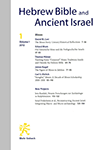
Hebrew Bible and Ancient Israel
Discovering the Threads of Ancient Cultures and Texts.Hebrew Bible and Ancient Israel is a premier scholarly journal published by MOHR SIEBECK, renowned for its rigorous contributions to the fields of biblical studies, ancient history, and archaeology. With its ISSN 2192-2276 and E-ISSN 2192-2284, this journal serves as a vital platform for researchers, professionals, and students interested in the historical and cultural contexts of the Hebrew Bible and its impact on ancient Israelite society. Although it does not currently offer an open access model, the journal is committed to disseminating critical research findings that enhance our understanding of ancient texts and their relevance to contemporary discussions. Situated in the scholarly landscape, Hebrew Bible and Ancient Israel not only strives to illuminate the complexities of biblical narratives but also engages with interdisciplinary approaches that enrich the study of ancient civilizations. Its publication out of Tübingen, Germany, further cements its role as a significant contributor to international academic discourse.